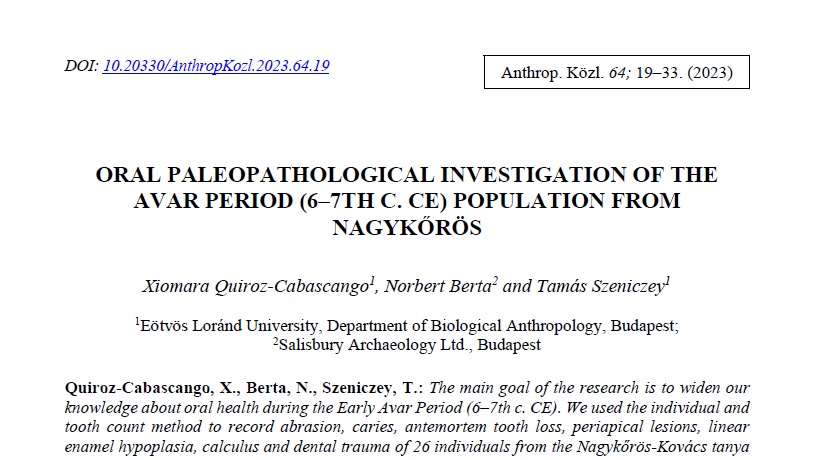Oral paleopathological investigation of the Avar period (6–7th c. CE) population from Nagykőrös
Absztrakt
The main goal of the research is to widen our knowledge about oral health during the Early Avar Period (6–7th c. CE). We used the individual and tooth count method to record abrasion, caries, antemortem tooth loss, periapical lesions, linear enamel hypoplasia, calculus and dental trauma of 26 individuals from the Nagykőrös-Kovács tanya site (9 males, 6 females, 11 subadults). The examination of the remains showed the noteworthy presence of dental abrasion and calculus among subadults, which increased with age. Only the tooth count analysis revealed a significant difference between the adults, as females had more teeth with caries and hypoplasia, while for calculus males had increased intensity in their dentition. The comparison with Late Avar Period skeletal assemblages from other geographic regions indicated possible spatial or temporal trends of oral health.
Hivatkozások
AlQahtani, S.J., Hector, M.P., Liversidge, H.M. (2010): Brief communication: The London atlas of human tooth development and eruption. American Journal of Physical Anthropology, 142(3): 481–490. DOI: 10.1002/ajpa.21258
Bonfiglioli, B., Mariotti, V., Facchini, F., Belcastro, M.G., Condemi, S. (2004): Masticatory and non-masticatory dental modifications in the epipalaeolithic necropolis of Taforalt. International Journal of Osteoarchaeology, 14(6): 448–456. DOI: https://doi.org/10.1002/oa.726
Brooks, S., Suchey, J. (1990): Skeletal age determination based on the os pubis. Human Evolution, 5(3): 227–238. DOI: https://doi.org/10.1007/BF02437238
Buikstra, J.E., Ubelaker, D.H. (1994): Standards for Data Collection from Human Skeletal Remains. Arkansas Archeological Survey Research Series N. 44., Arkansas, USA. p. 272.
Éry, K., Kralovánszky, A., Nemeskéri, J. (1963): Történeti népességek rekonstrukciójának reprezentációja. Anthropologiai Közlemények, 7: 41–90.
Évinger, S. (2003): A Toponár és Fészerlak avar kori temetők népességének paleosztomatológiai vizsgálata. Békés Megyei Múzeumok Közleményei, 24-25: 429–448.
Forshaw, R. (2004): Dental indicators of ancient dietary patterns: dental analysis in archaeology. British Dental Journal, 216: 529–535. DOI: https://doi.org/10.1038/sj.bdj.2014.353
Garam, É. (2018): Das awarenzeitliche Gräberfeld in Zamárdi-Rétiföldek. Teil III. Monumenta Avarorum Archaeologica 12. Magyar Nemzeti Múzeum, Budapest. p. 416.
Horváth, G., Molnár, E., Marcsik, A. (1995). Taurodontism and enamel hypoplasia in a skeletal sample (8th century) from Szarvas, Hungary. In: Moggi-Cecchi, J. (Ed.) Aspects of Dental Biology: Palaeontology, Anthropology and Evolution. IISM, Florence. pp. 377–387.
Huszár, G., Schranz, D. (1976:. A fogszuvasodás elterjedése a Dunántúlon, az újkőkortól az újkorig. Fogorvosi Szemle, 45: 3–38.
Iscan, Y.M., Loth, S.R., Wright, R.K. (1984): Age estimation from the rib by phase analysis: white males. Journal of Forensic Sciences, 29(4): 1094–1104. DOI: https://doi.org/10.1520/JFS11776J
Iscan, Y.M., Loth, S.R., Wright, R.K. (1985): Age estimation from the rib by phase analysis: white females. Journal of Forensic Sciences, 30(3): 853–863. DOI: https://doi.org/10.1520/JFS11018J
Lovejoy, C.O. (1985): Dental wear in the Libben population. American Journal of Physical Anthropology, 68(1): 47–56. DOI: 10.1002/ajpa.1330680105
Meindl, R.S., Lovejoy, C.O. (1985): Ectocranial suture closure: a revised method for the determination of skeletal age at death based on the lateral-anterior sutures. American Journal of Physical Anthropology, 68(1): 57–66. DOI: https://doi.org/10.1002/ajpa.1330680106
Meinl, A., Rottensteiner, G.M., Huber, C.D., Tangl, S., Watzak, G., Watzek, G. (2010): Caries frequency and distribution in an early medieval Avar population from Austria. Oral Diseases, 16(1): 108–116. DOI: https://doi.org/10.1111/j.1601-0825.2009.01624.x
Molnár, E. (2000): Systematic Anthropological examination of an Avar age cemetery (Pitvaros-Víztározó), University of Szeged. http://doktori.bibl.u-szeged.hu/id/eprint/2/3/tz_en2.html
Nikita, E. (2016): Osteoarchaeology: A guide to the macroscopic study of human skeletal remains. Academic Press, Amsterdam. p. 409.
Pohl, W. (2018): The Avars: A Steppe Empire in Central Europe. CUP, Ithaca, London, UK. pp. 636.
Schaefer, M.C., Black, S., Scheuer, L. (2008): Juvenile Osteology: A Laboratory and Field Manual. Academic Press, Amsterdam, The Netherlands. p. 384.
Smith, C.B., Littleton, J. (2019): Enamel defects at Roonka, South Australia: indicators of poor health or the osteological paradox? Australian Archaeology, 85(2): 139–150. DOI: https://doi.org/10.1080/03122417.2019.1644863
Vida, T. (2008). Conflict and coexistence: the local population of the Carpathian Basin under Avar rule (sixth to seventh century). In: Curta, F. (Ed.) The Other Europe in the Middle Ages: Avars, Bulgars, Khazars and Cumans. Brill, Leiden, The Netherlands. pp. 13–46.




